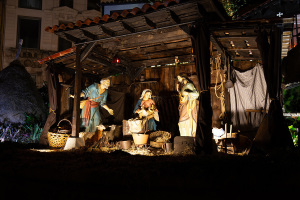Report Paints Picture of the Average US Megachurch
In the history of the more than 2,000-year-old Christian Church, megachurches have only been around for about 1 percent of the time, according to one California pastor, yet they continue to grow in numbers and sizes, impacting the rest of the world.
An infographic recently done by the graphic design and statistical research company, Good, attempts to show what the average megachurch looks like. It reveals that 83 percent of the megachurches in the U.S. grew in 2009.
A megachurch is defined by the company as a Protestant congregation with 2,000 or more members. The definition also includes the note that megachurches differ in style, targeting young people with services that are often held in auditoriums and theaters instead of worship halls.
According to the report, based on information from Leadership Network, The Christian Post and Forbes, the average weekend worship attendance is 2,000-2,999 members. Fifty-six percent of megachurches are evangelical, and the rest such as those that are Charismatic or Pentecostal divided fairly evenly in much smaller percentages. Also, nearly half (48 percent) of megachurches are located in a young suburb outside a major city.
The average number of full-time staff members at a megachurch is 59 and the average age of a senior pastor leading a large church is 50. Additional details from the infographic show that the average megachurch is predominantly white.
Perhaps the largest growth in membership is among churches already high in attendance. Churches with between 10,000 to 15,000 people attending grew by 100 percent in 2009.
Many of today’s megachurches, such as Saddleback Church in Lake Forest, Calif., are now sharing their formulas for successful growth with other pastors from not only in the United States, but around the world.
Saddleback’s global training pastor, Dave Holden, has a network of 30,000 pastors who have received guidance on planting and growing a “Purpose Driven” church. The model for this type of church was developed in the writing of Rick Warren’s book, The Purpose Driven Church, a precursor to his bestselling The Purpose Driven Life.
Holden, who planted his first church in 1987, said that during the same time period, if a church grew to 1,000 members it was in the top 5 percent of churches in the U.S.
“The whole megachurch journey is really only about 25 years old,” Holden said. “Today, there are many megachurches and lots of churches that are 10,000 and more. The good news about the megachurch, as the infographic shows, is that they are definitely growing.”
Holden said he finds one missing element in most discussions and statistics about megachurches.
“The thing they are primarily successful at is that they are reaching new people for Christ,” he said. “That’s the thing that is maybe ignored in these graphics.”
“Megachurches specialize in reaching new people and not attracting existing Christians. For example, of the churches that I know the best, and those are Purpose Driven churches, about 76 percent of the members have been baptized in their church. I have a very positive view of the megachurch,” Holden said.
He finds that those with negative views of megachurches often base their opinion on something untrue.
“Sometimes people say, ‘Well, I would never go to a megachurch because it just feels so impersonal and unfriendly.’ But, the fact of the matter is you don’t grow to be a huge megachurch if you are not very friendly because that is what keeps people coming – for relationship, for fellowship, and all those kinds of things,” he said.
Holden acknowledged that the style of a church, including worship style is probably the biggest attraction at first for people to a megachurch.
“But once they get inside they’re reached by the message preached by a preacher in a contemporary way that makes a lot of sense so that they can respond to Christ,” he stressed.
Another important element in keeping people at a large church is making sure the church has a vibrant small group or Bible study ministry, he added.
“Once they respond to Christ and find love and acceptance in a small group then that small group becomes a bridge that they can walk across and get deeper and deeper into their relationship with Jesus Christ.”
“We have developed a style of managing our church by making the church into smaller pieces that we call small groups. And those small groups are where primary needs are being met for fellowship and even very deep Bible study,” Holden explained. “The small group is an indispensable part of the plan, but it’s a bridge from the outside of the congregation into the very heart of the congregation and into what we believe.”
Large churches are currently taking on a different shape, he noted.
“Megachurches are now planting other churches. You also see churches reproducing themselves in what we call venues. These are on-campus or off-campus sites,” he said. “Over time, these become their own full-time ministry.”
“The megachurch phenomena is not going to look the same, but the next growth step for the megachurch movement is that these churches are going to very aggressively launch campaigns to reproduce themselves in smaller churches through church planting throughout the world.”
“I think that’s very good and very healthy,” he added.



























